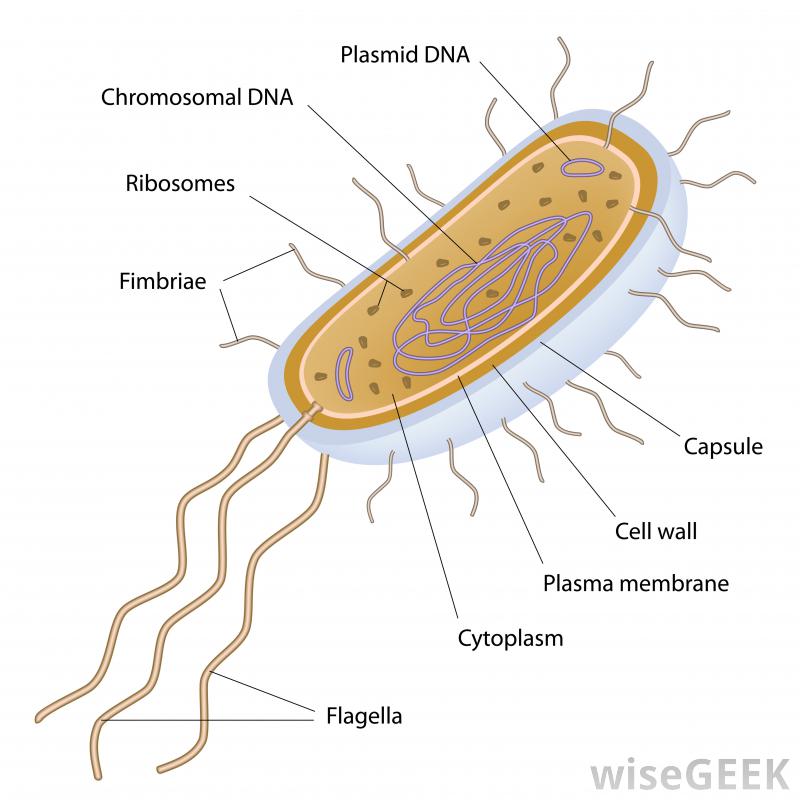
Bacterial Cell Diagrams 101 Diagrams
Bacterial cells have simpler internal structures like Pilus (plural Pili), Cytoplasm, Ribosomes, Capsule, Cell Wall, Plasma membrane, Plasmid, Nucleoid, Flagellum, etc. Labeled Bacteria diagram Eukaryotes have been shown to be more recently evolved than prokaryotic microorganisms.

Bacterial Cell Structure and Function
Figure 1. Cutaway drawing of a typical bacterial cell illustrating structural components. See Table 2 below for chemical composition and function of the labeled components. Table 2. Summary of characteristics of typical bacterial cell structures. Structure. Flagella. Function (s) Swimming movement.

Bacterial Structure Plantlet
Prokaryotes are single-celled organisms belonging to the domains Bacteria and Archaea. Prokaryotic cells are much smaller than eukaryotic cells, have no nucleus, and lack organelles. All prokaryotic cells are encased by a cell wall. Many also have a capsule or slime layer made of polysaccharide.

bacterial cell diagram and functions
Wall-Less Forms: Two groups of bacteria devoid of cell wall peptidoglycans are the Mycoplasma species, which possess a surface membrane structure, and the L-forms that arise from either Gram-positive or Gram-negative bacterial cells that have lost their ability to produce the peptidoglycan structures. Cytoplasmic Structures

Bacteria Ms A Science Online
Structure of Bacterial Cell (With Diagram) Article Shared by ADVERTISEMENTS: In this article we will discuss about the Structure of Bacterial Cell. Bacteria (sing. bacterium) are unicellular prokaryotic microorganisms which divide by binary fission.

Characteristics of bacterial cells
coccus (circle or spherical) bacillus (rod-like) coccobacillus (between a sphere and a rod) spiral (corkscrew-like) filamentous (elongated) Cell shape is generally characteristic of a given bacterial species, but can vary depending on growth conditions.

What part of the bacteria cell helps it stick to surfaces? Socratic
Bacterial cells were once presumed to be 'bags of enzymes' with minimal oganization 1.Yet, in the past 10 years, numerous studies have demonstrated that bacteria compartmentalize many cellular.

Bacterial cell anatomy in flat style. Vector modern illustration. Labeling structures on a
August 14, 2021. Bacteria are unicellular. Their structure is a very simple type. Bacteria are prokaryotes because they do not have a well-formed nucleus. A typical bacterial cell is structurally very similar to a plant cell. The cell structure of a bacterial cell consists of a complex membrane and membrane-bound protoplast.

Pin by Magpie on ชีวะ Prokaryotic cell, Eukaryotic cell, Prokaryotic cell model
A bacterial cell (Fig. 2.5) shows a typical prokaryotic structure. The cytoplasm is enclosed by three layers, the outermost slime or capsule, the middle cell wall and inner cell membrane.

Bacterial Structure Plantlet
Shape and Arrangement-1 Cocci (s., coccus) - spheres diplococci (s., diplococcus) - pairs streptococci - chains staphylococci - grape-like clusters tetrads - 4 cocci in a square sarcinae - cubic configuration of 8 cocci Shape and Arrangement-2 bacilli (s., bacillus) - rods coccobacilli - very short rods

Bacterial cell structure and function YouTube
These can rotate or move in a whip-like motion to move the bacterium. Plant and bacterial cell walls provide structure and protection. Only plant cell walls are made from cellulose. The DNA of.

Bacterial Cell Structure and Function
A prokaryote is a simple, single-celled organism that lacks a nucleus and membrane-bound organelles.

Innovic Medical Bacterial Cell Structure
Flagella Pili (Fimbriae) Spores Cell wall The bacteria's cell wall is the outer rigid and chemically complex structure. It is in between the cell membrane and the capsule/slime layer. The cell wall of the bacteria maintains the shape of the cell and protects the bacteria from changes in osmotic pressure.

Bacteria Cell Vector Art, Icons, and Graphics for Free Download
Bacteria are prokaryotes, lacking well-defined nuclei and membrane-bound organelles, and with chromosomes composed of a single closed DNA circle. They come in many shapes and sizes, from minute spheres, cylinders and spiral threads, to flagellated rods, and filamentous chains.

prokaryotic cell bacteria parts
Bacterial cells are between about 1 and 10 μm long. And most of them are only 1 to 2 μm in diameter. 1 μm, or micrometre, is 1 000 times smaller than a millimetre.. Bacterial Structure. Click on the numbers to learn more about the parts of a bacterial cell. To the right, the second is an oval-shaped, crusty loaf of bread with a paper.

5.E The Cell (Exercises) Biology LibreTexts
Capsule. A bacterial capsule is a polysaccharide layer that completely envelopes the cell. It is well organized and tightly packed, which explains its resistance to staining under the microscope. The capsule offers protection from a variety of different threats to the cell, such as desiccation, hydrophobic toxic materials (i.e. detergents), and bacterial viruses.